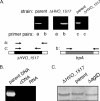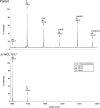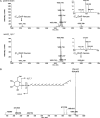AglJ adds the first sugar of the N-linked pentasaccharide decorating the Haloferax volcanii S-layer glycoprotein
- PMID: 20802039
- PMCID: PMC2953680
- DOI: 10.1128/JB.00705-10
AglJ adds the first sugar of the N-linked pentasaccharide decorating the Haloferax volcanii S-layer glycoprotein
Abstract
Like the Eukarya and Bacteria, the Archaea also perform N glycosylation. Using the haloarchaeon Haloferax volcanii as a model system, a series of Agl proteins involved in the archaeal version of this posttranslational modification has been identified. In the present study, the participation of HVO_1517 in N glycosylation was considered, given its homology to a known component of the eukaryal N-glycosylation pathway and because of the genomic proximity of HVO_1517 to agl genes encoding known elements of the H. volcanii N-glycosylation process. By combining the deletion of HVO_1517 with mass spectrometric analysis of both dolichol phosphate monosaccharide-charged carriers and the S-layer glycoprotein, evidence was obtained showing the participation of HVO_1517, renamed AglJ, in adding the first hexose of the N-linked pentasaccharide decorating this reporter glycoprotein. The deletion of aglJ, however, did not fully prevent the attachment of a hexose residue to the S-layer glycoprotein. Moreover, in the absence of AglJ, the level of only one of the three monosaccharide-charged dolichol phosphate carriers detected in the cell was reduced. Nonetheless, in cells lacking AglJ, no further sugar subunits were added to the remaining monosaccharide-charged dolichol phosphate carriers or to the monosaccharide-modified S-layer glycoprotein, pointing to the importance of the sugar added through the actions of AglJ for proper N glycosylation. Finally, while aglJ can be deleted, H. volcanii surface layer integrity is compromised in the absence of the encoded protein.
Figures






Similar articles
-
AglR is required for addition of the final mannose residue of the N-linked glycan decorating the Haloferax volcanii S-layer glycoprotein.Biochim Biophys Acta. 2012 Oct;1820(10):1664-70. doi: 10.1016/j.bbagen.2012.06.014. Epub 2012 Jun 27. Biochim Biophys Acta. 2012. PMID: 22750201 Free PMC article.
-
Distinct glycan-charged phosphodolichol carriers are required for the assembly of the pentasaccharide N-linked to the Haloferax volcanii S-layer glycoprotein.Mol Microbiol. 2010 Dec;78(5):1294-303. doi: 10.1111/j.1365-2958.2010.07405.x. Epub 2010 Oct 8. Mol Microbiol. 2010. PMID: 21091511 Free PMC article.
-
N-Glycosylation Is Important for Proper Haloferax volcanii S-Layer Stability and Function.Appl Environ Microbiol. 2017 Mar 2;83(6):e03152-16. doi: 10.1128/AEM.03152-16. Print 2017 Mar 15. Appl Environ Microbiol. 2017. PMID: 28039139 Free PMC article.
-
Add salt, add sugar: N-glycosylation in Haloferax volcanii.Biochem Soc Trans. 2013 Feb 1;41(1):432-5. doi: 10.1042/BST20120142. Biochem Soc Trans. 2013. PMID: 23356324 Review.
-
S-layer glycoproteins and flagellins: reporters of archaeal posttranslational modifications.Archaea. 2010 Jul 20;2010:612948. doi: 10.1155/2010/612948. Archaea. 2010. PMID: 20721273 Free PMC article. Review.
Cited by
-
Functional genomic and advanced genetic studies reveal novel insights into the metabolism, regulation, and biology of Haloferax volcanii.Archaea. 2011;2011:602408. doi: 10.1155/2011/602408. Epub 2011 Nov 30. Archaea. 2011. PMID: 22190865 Free PMC article.
-
Identifying Components of a Halobacterium salinarum N-Glycosylation Pathway.Front Microbiol. 2021 Dec 2;12:779599. doi: 10.3389/fmicb.2021.779599. eCollection 2021. Front Microbiol. 2021. PMID: 34925283 Free PMC article.
-
Different routes to the same ending: comparing the N-glycosylation processes of Haloferax volcanii and Haloarcula marismortui, two halophilic archaea from the Dead Sea.Mol Microbiol. 2011 Sep;81(5):1166-77. doi: 10.1111/j.1365-2958.2011.07781.x. Epub 2011 Aug 4. Mol Microbiol. 2011. PMID: 21815949 Free PMC article.
-
Biochemical evidence for an alternate pathway in N-linked glycoprotein biosynthesis.Nat Chem Biol. 2013 Jun;9(6):367-73. doi: 10.1038/nchembio.1249. Epub 2013 Apr 28. Nat Chem Biol. 2013. PMID: 23624439 Free PMC article.
-
Protein glycosylation as an adaptive response in Archaea: growth at different salt concentrations leads to alterations in Haloferax volcanii S-layer glycoprotein N-glycosylation.Environ Microbiol. 2012 Mar;14(3):743-53. doi: 10.1111/j.1462-2920.2011.02625.x. Epub 2011 Oct 26. Environ Microbiol. 2012. PMID: 22029420 Free PMC article.
References
-
- Abu-Qarn, M., and J. Eichler. 2006. Protein N-glycosylation in Archaea: defining Haloferax volcanii genes involved in S-layer glycoprotein glycosylation. Mol. Microbiol. 61:511-525. - PubMed
-
- Abu-Qarn, M., S. Yurist-Doutsch, A. Giordano, A. Trauner, H. R. Morris, P. Hitchen, O. Medalia, A. Dell, and J. Eichler. 2007. Haloferax volcanii AglB and AglD are involved in N-glycosylation of the S-layer glycoprotein and proper assembly of the surface layer. J. Mol. Biol. 374:1224-1236. - PubMed
-
- Burda, P., and M. Aebi. 1999. The dolichol pathway of N-linked glycosylation. Biochim. Biophys. Acta 1426:239-257. - PubMed
Publication types
MeSH terms
Substances
Associated data
- Actions
Grants and funding
LinkOut - more resources
Full Text Sources
Molecular Biology Databases

